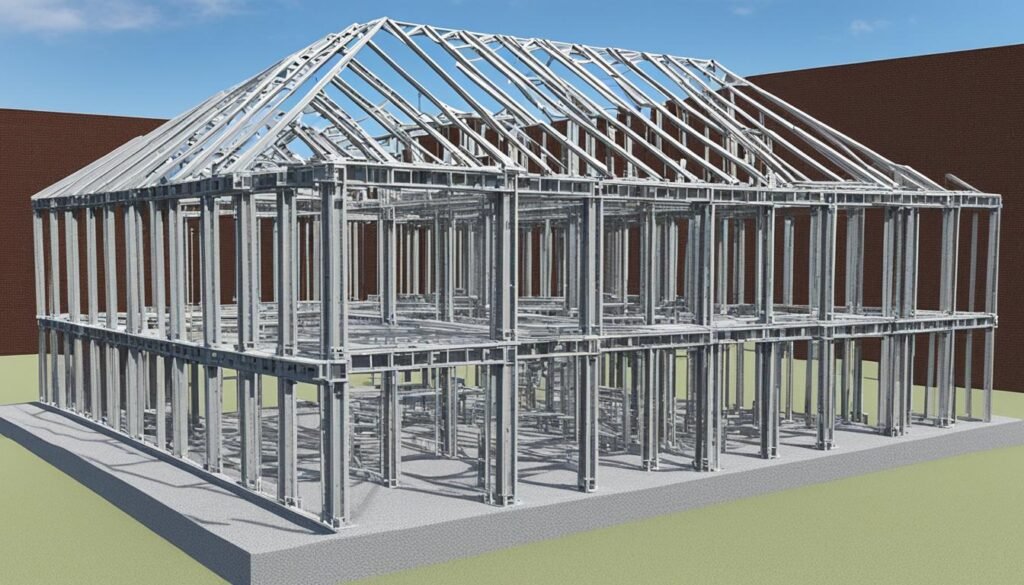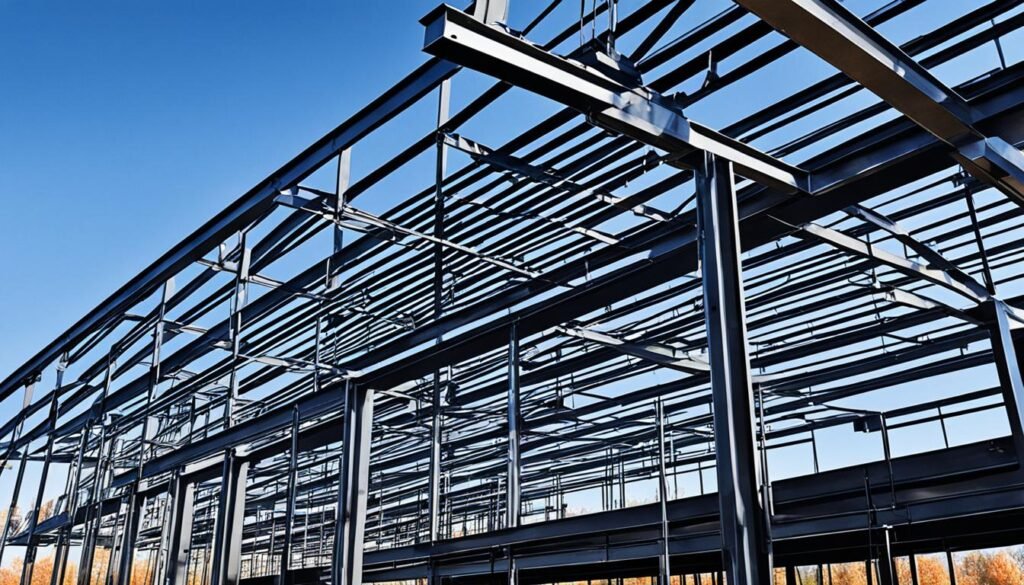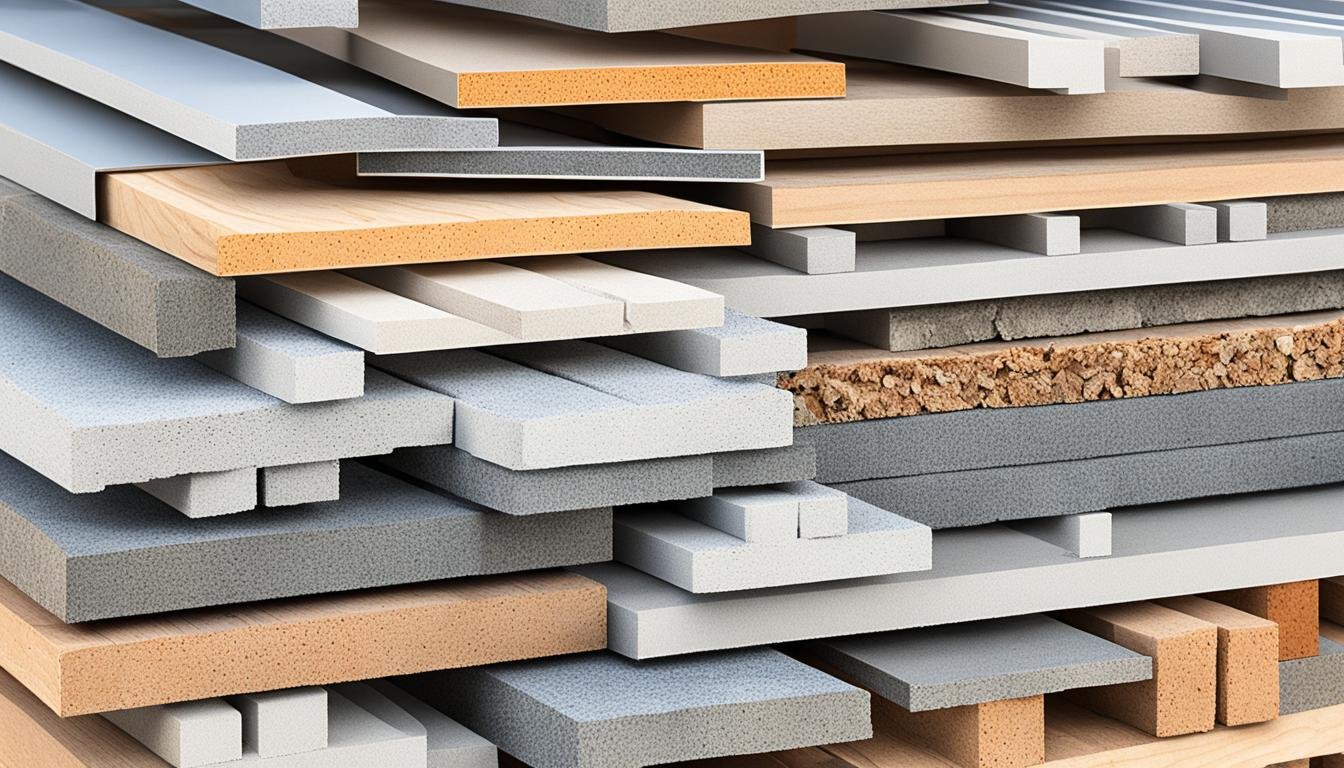Have you ever thought about how buildings around us are made? The ones that shelter and protect us? The making of buildings is interesting. Especially, how the choice of building framing materials affects their strength and life.
Choosing the right materials is important, whether for homes or big businesses. The materials impact the building’s strength, energy use, and safety. They also affect the costs of keeping the building up. This choice influences the building’s whole life.
In this article, we discuss top building framing materials for construction. We’ll cover what each material offers. You’ll learn about their pros and cons. This knowledge will help you choose wisely for your project, aiming for a lasting building.
Key Takeaways:
- Choosing the right framing materials is crucial for construction projects.
- The choice of framing materials affects the strength, energy efficiency, and maintenance requirements of the building.
- We will explore the top building framing materials and their unique advantages.
- Understanding the strengths and weaknesses of each option will help you make an informed decision for your project.
- Ensure the durability and longevity of your building by selecting the most suitable framing materials.
Types of Framing Materials
There are many framing materials available for construction. Each one comes with its unique traits and advantages. To pick the right one for your project, it’s crucial to understand these differences.
Wood Framing
Wood framing is a favorite among builders for many reasons. It’s versatile, affordable, and easy to find. You can easily tailor it to suit any design, and it brings a certain warmth to buildings. But, it does have a downside – it can get damaged by moisture and termites. So, it’s important to protect it properly.
CMUs (Concrete Masonry Units)
Concrete masonry units, or CMUs, are great for areas at risk of fire or moisture. They help keep the building fire-safe and dry. CMUs are also good for keeping a place warm and quiet. But, putting them up takes more work and insulation than some other methods.
Steel Framing
Steel framing stands out for its strength and durability. It’s perfect for buildings that need extra support or are in termite-heavy areas. It’s safe from fire, pests, and moisture. But, steel costs more and needs skilled workers for installation. It also needs proper insulation for energy savings.
ICFs (Insulated Concrete Forms)
Insulated Concrete Forms, or ICFs, are getting popular because they’re energy-efficient and strong. They’re made of foam panels filled with concrete. This makes a tough and well-insulated wall that saves on energy bills. ICFs can also withstand severe weather like tornadoes and hurricanes. The higher initial costs and need for expert installers are worth noting, though.
Choosing the right framing material depends on your project’s needs, budget, and energy goals. Always talk to experts and check local codes to make the best choice.
| Framing Material | Benefits |
|---|---|
| Wood Framing | Versatile, affordable, customizable |
| CMUs | Fire and moisture resistance, good insulation |
| Steel Framing | Strong, termite-resistant, durable |
| ICFs | Energy-efficient, disaster-resistant, low maintenance |
Benefits of Wood Framing
Wood framing stands out as a top choice for building. It’s the most popular and cost-effective option for frames. Wood is everywhere, making it easy for builders to get and afford. It’s perfect for both pros and beginners because of its flexibility. It lets you create any design, whether it’s for a house or a business.
Why pick wood framing? It’s cheap, which is great for tight budgets. Plus, wood is light. This makes it easy to move and work with on-site. And, setting it up fast means you can save on labor costs.
Wood framing is also great for keeping your place warm or cool, saving you money on energy. But, wood can be vulnerable to water and bugs. To avoid damage, you need to use moisture barriers and treat the wood for termites. Regular upkeep is key with wood frames.
Advantages of CMU Framing
CMU framing, or concrete masonry units, brings several benefits to building projects. They are fireproof and resist moisture well, which makes them strong and easy to take care of. Additionally, they insulate against heat and noise well and pests like termites don’t affect them.
CMU construction stands out for its strength and long life. The toughness of CMUs helps protect against fire. This is key for buildings in wildfire-prone zones or where fire safety is a major concern.
“CMU framing provides excellent fire resistance, offering peace of mind and added safety for your construction project.”
CMUs block moisture effectively thanks to their dense makeup. This makes them perfect for buildings in wet or coastal places. They prevent mold, mildew, and wood rot, saving on repair and upkeep costs.
CMUs help keep indoor temperatures stable. They have a high thermal mass, absorbing heat during the day and releasing it at night. This keeps indoors comfortable and saves on energy costs.
Moreover, CMUs are great at blocking sound, limiting noise from outside and between rooms. This feature is especially useful in commercial spaces, apartment buildings, and near busy areas.
However, CMU framing does have its downsides. It’s more labor-intensive and time-consuming than other methods. Laying CMUs requires precision and additional insulation might be needed to boost energy efficiency. This extra insulation enhances the building’s warmth and energy use.
CMU Framing Advantages Summary
- Fire-resistant construction
- Excellent moisture resistance
- Good thermal insulation
- Superior sound insulation
- Resistance to pests, such as termites
A visually engaging and informative table comparing the advantages of different framing materials is provided below:
| Framing Material | Advantages |
|---|---|
| Wood | Versatile, affordable, design flexibility |
| CMU Framing | Fire-resistant, moisture-resistant, good thermal and sound insulation, resistance to pests |
| Steel | Strong, termite-resistant, resistant to fire and moisture |
| ICFs | Energy-efficient, durable, disaster-resistant |

Strengths of Steel Framing
Steel framing is a top choice for buildings needing more support. It offers many strengths and advantages in construction. Let’s look into what makes steel framing stand out.
Steel is known for its amazing strength. It’s tough enough to handle heavy loads and keeps buildings stable. This is why it’s great for big projects like high-rises and commercial buildings.
Steel beats wood in resisting fire, pests, and moisture. It doesn’t burn, which lowers fire risk. It’s also immune to termites, saving money on pest control. Because steel resists moisture, problems like rot and mold don’t happen.
Choosing steel framing has its considerations. It may cost more at first than wood or concrete. But, in the long run, steel’s benefits and lower upkeep costs make it a smart pick.
Insulation for Energy Efficiency
Insulating steel-framed buildings is key to saving energy. Steel conducts heat, leading to potential energy loss. Without proper insulation, energy bills could rise.
To keep buildings energy-efficient, add insulation like foam panels or fiberglass batts. This makes steel structures more eco-friendly and comfortable.
Steel framing is great for strong and durable buildings. With the right insulation, these buildings save energy too. They stand the test of time and keep energy costs down.

| Advantages | Considerations |
|---|---|
| Exceptional strength and structural stability | Higher initial cost compared to other materials |
| Resistance to fire, pests, and moisture | Requires skilled labor for proper installation |
| Long-lasting durability | Proper insulation is essential for energy efficiency |
Benefits of ICF Framing
Insulated Concrete Forms (ICFs) offer many advantages for both residential and commercial builds. They are great for saving energy, lasting a long time, and being kind to the planet.
Superior Energy Efficiency
ICFs are top-notch in saving energy. They have a high R-value, which means they insulate well. The materials used help keep indoor temperatures steady. This cuts down on the need for heating and cooling.
Less energy to keep rooms comfy means lower energy bills.
Disaster Resistance
ICFs stand strong against tornadoes and hurricanes. The concrete core makes buildings more stable against strong winds and shocks. They are a smart pick for areas that face harsh weather, making buildings safer and sturdier.
Excellent Sound Insulation
ICFs also block out noise really well. The concrete core and foam panels keep outside noise from getting in. This is perfect for buildings in loud areas, making inside spaces quieter and more peaceful.
Eco-Friendly Framing Option
Choosing ICFs means choosing a greener building method. They are made with engineered wood, cutting down the use of steel or concrete. This reduces carbon emissions and supports a greener build process.
Their energy-saving nature also means less energy use overall. This makes ICFs an eco-conscious choice.
Easy Installation and Low Maintenance
ICFs are easy to put together, which can save time and money on building projects. The foam panels fit together easily, speeding up the build and lowering labor costs. Once built, ICF buildings don’t need much upkeep. This saves more time and money over time.
Their sturdy design means less need for repairs.
In summary, ICFs bring many benefits to the table for building projects. They enhance energy saving, withstand disasters, block out noise, are eco-friendly, and easy to maintain. This makes them a solid, sustainable, and cost-effective framing choice.
Comparing Framing Methods – Strengths and Weaknesses
When looking for the best framing materials for construction, it’s crucial to weigh their pros and cons. Each technique brings its own benefits and drawbacks that can influence your project’s outcome.
Wood Framing
Strengths: Wood framing stands out for its cost-effectiveness and adaptability. It’s widely available and simple to handle, thus favored by many builders. This method also supports creative designs to meet unique project demands.
Weaknesses: Yet, wood framing needs consistent upkeep to guard against moisture and termites. You also must ensure it’s properly insulated and safe from fire.
CMU Framing
Strengths: CMU framing excels in resisting fire and moisture. These blocks are durable with minimal upkeep required, ideal for enduring structures. They provide excellent insulation for both temperature and sound and keep termites at bay.
Weaknesses: But, CMU constructions need extra insulation for energy efficiency. They also demand more labor compared to other methods.
Steel Framing
Strengths: Known for robustness, steel framing supports structures needing extra strength. It is fire, pest, and moisture-resistant, ensuring longevity and safety of constructions.
Weaknesses: However, steel framing can cost more and often requires experienced workers for setup. It needs careful insulation since steel conducts heat well.
ICF Framing
Strengths: ICFs stand out for superior energy-saving and resilience against disasters. They provide excellent insulation and are gentle on the environment by using fewer materials and lowering energy use.
Weaknesses: Despite its advantages, ICF framing can be pricier initially and might need skilled labor more so than other methods.
Picking the right framing method means looking at what your project needs, your budget, and future plans. Each option has its trade-offs, so it’s key to choose materials that fit your specific requirements.
Here’s a quick overview of the pros and cons of different framing methods:
| Framing Method | Strengths | Weaknesses |
|---|---|---|
| Wood Framing | Affordable, versatile | Maintenance, vulnerability to moisture and termites |
| CMU Framing | Fire and moisture resistance, low-maintenance | Additional insulation, labor-intensive |
| Steel Framing | Strength, durability, resistance to fire and pests | Higher cost, skilled labor, heat conduction |
| ICF Framing | Energy efficiency, disaster resistance, eco-friendly | Skilled labor, higher upfront costs |
By evaluating each method’s strengths and weaknesses, you can make a smart choice on the best framing materials for your project.
Conclusion
Choosing the right materials for framing in construction is key to durability, saving energy, and long-term value. It’s important to look at each option carefully. Think about the pros and cons of wood, CMUs, steel, and ICFs. You should also consider costs, energy saving, disaster resistance, and upkeep.
The ideal framing materials depend on your needs, budget, and objectives. Speak with seasoned construction pros for their advice. Their know-how and experience can guide you. This way, you’ll pick materials that give you quality, value, and strong performance.
Quality framing materials ensure your building is strong and lasts a long time. They also make your building more energy-efficient and green. Picking the best materials for your project means your structure will stand strong and perform well for many years.


